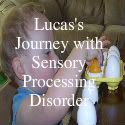I am very honored she wanted to guest post. Please read her wonderful post below.


or find her on Facebook or Twitter. If you post her Event button on your blog and let her know you did by commenting here, you can have 5 extra entries into both the Barefoot Books Giveaway, and A Blanket Full of Love Giveaway.
Tell me about yourself and your family.
or by sending a tweet or email to the media contacts that we have listed here. http://lucasjourneyspd.blogspot.com/2010/09/sensational-celebration-media-contacts.html
We just revised the entry form to make it a little easier to enter.
We have received over $2,000 in prizes that were donated to help raise awareness for SPD. This turned into so much more than I ever expected! We’ve had more of a turnout that I could have imagined but we are still in dire need of help getting our message out to the media.
We are also giving entries for any donations made or badges that are purchased that we have for sale which can be found on any page of our blog on the left hand sidebar. All proceeds will be donated to the SPD foundation’s event.
Here is the explanation of what SPD is taken from the SPD foundation:
.
About Sensory Processing Disorder (taken from the SPD Foundations site, full explanation can be found at http://www.spdfoundation.net/about-sensory-processing-disorder.html )
Sensory processing (sometimes called “sensory integration” or SI) is a term that refers to the way the nervous system receives messages from the senses and turns them into appropriate motor and behavioral responses. Whether you are biting into a hamburger, riding a bicycle, or reading a book, your successful completion of the activity requires processing sensation or “sensory integration.”
Sensory Processing Disorder (SPD, formerly known as “sensory integration dysfunction”) is a condition that exists when sensory signals don’t get organized into appropriate responsesPioneering occupational therapist and neuroscientist A. Jean Ayres, PhD, likened SPD to a neurological “traffic jam” that prevents certain parts of the brain from receiving the information needed to interpret sensory information correctly. A person with SPD finds it difficult to process and act upon information received through the senses, which creates challenges in performing countless everyday tasks. Motor clumsiness, behavioral problems, anxiety, depression, school failure, and other impacts may result if the disorder is not treated effectively.
Symptoms of Sensory Processing Disorder, like those of most disorders, occur within a broad spectrum of severity. While most of us have occasional difficulties processing sensory information, for children and adults with SPD, these difficulties are chronic, and they disrupt everyday life.
What Sensory Processing Disorder looks like
Sensory Processing Disorder can affect people in only one sense–for example, just touch or just sight or just movement–or in multiple senses. One person with SPD may over-respond to sensation and find clothing, physical contact, light, sound, food, or other sensory input to be unbearable. Another might under-respond and show little or no reaction to stimulation, even pain or extreme hot and cold. In children whose sensory processing of messages from the muscles and joints is impaired, posture and motor skills can be affected. These are the “floppy babies” who worry new parents and the kids who get called “klutz” and “spaz” on the playground. Still other children exhibit an appetite for sensation that is in perpetual overdrive. These kids often are misdiagnosed – and inappropriately medicated – for ADHD.
Sensory Processing Disorder is most commonly diagnosed in children, but people who reach adulthood without treatment also experience symptoms and continue to be affected by their inability to accurately and appropriately interpret sensory messages.
These “sensational adults” may have difficulty performing routines and activities involved in work, close relationships, and recreation. Because adults with SPD have struggled for most of their lives, they may also experience depression, underachievement, social isolation, and/or other secondary effects.
Sadly, misdiagnosis is common because many health care professionals are not trained to recognize sensory issues. The Sensory Processing Disorder Foundation is dedicated to researching these issues, educating the public and professionals about their symptoms and treatment, and advocating for those who live with Sensory Processing Disorder and sensory challenges associated with other conditions.
Latest posts by Emily (Posts)
- Don’t Call It A Comeback - February 7, 2019
- The Little Prince at The Smith Center Las Vegas – Ticket Giveaway - January 31, 2017
- 3 Simple Ways To Add Color To Your Diet @SUBWAY @OfficialSubway - January 13, 2017
- Disney’s Moana in Dolby Cinema at AMC Movie Review - November 27, 2016







Thank you Emily! My son Charlie thinks he's a star now that his picture is on your blog! He is calling all of his friends to tell them. I heard him say "My picture is on this famous ladies blog in Las Vegas! Yeah the place on Wonder Pets! LOL
I think you are pretty amazing too! Thank you for sharing our story on your blog! It really means the world to us!
Have a great day!
Debbie 😉